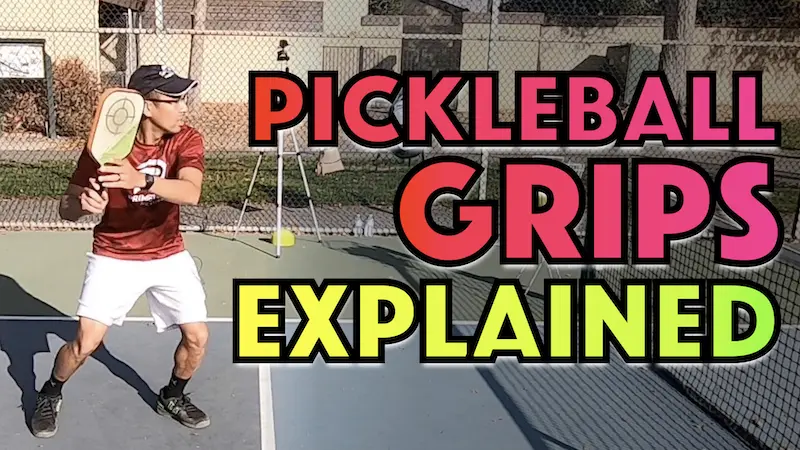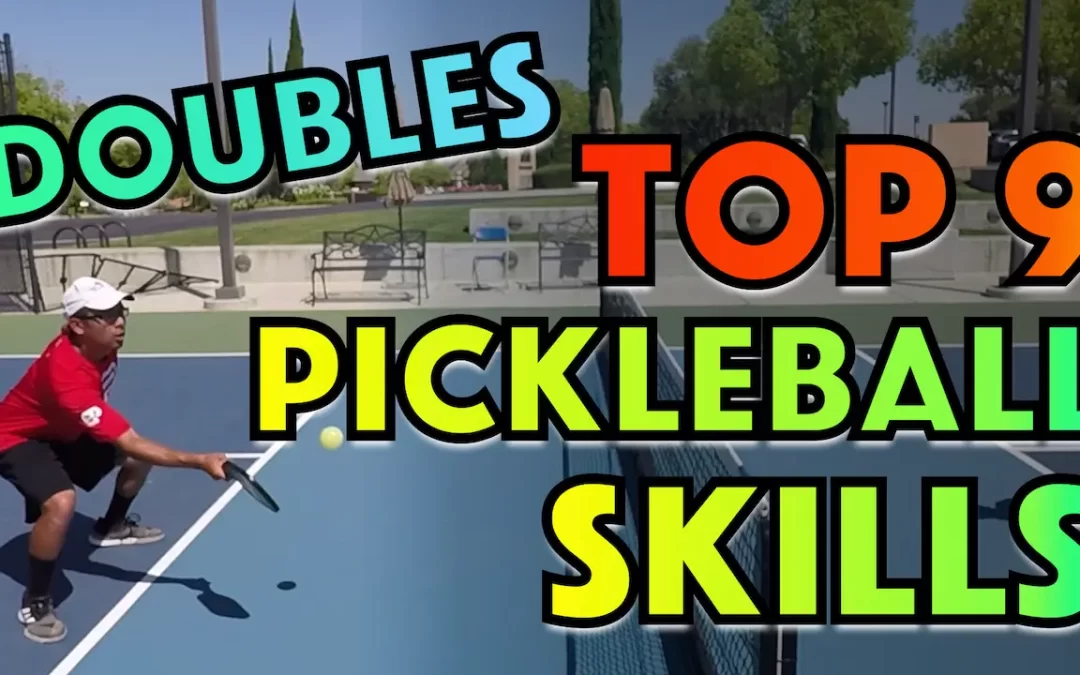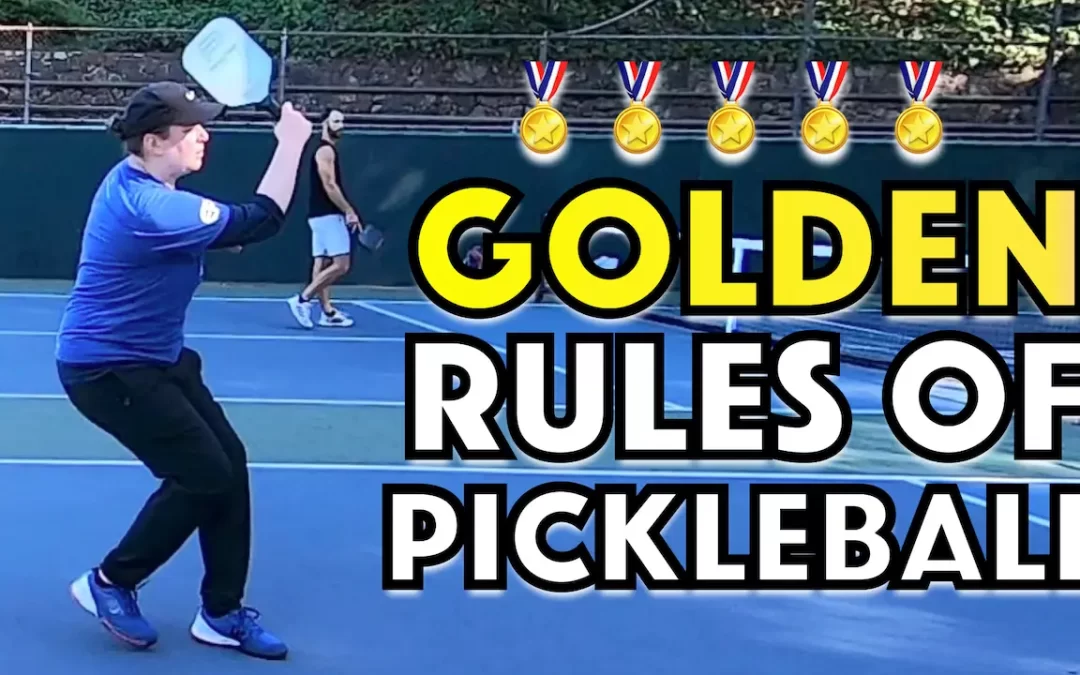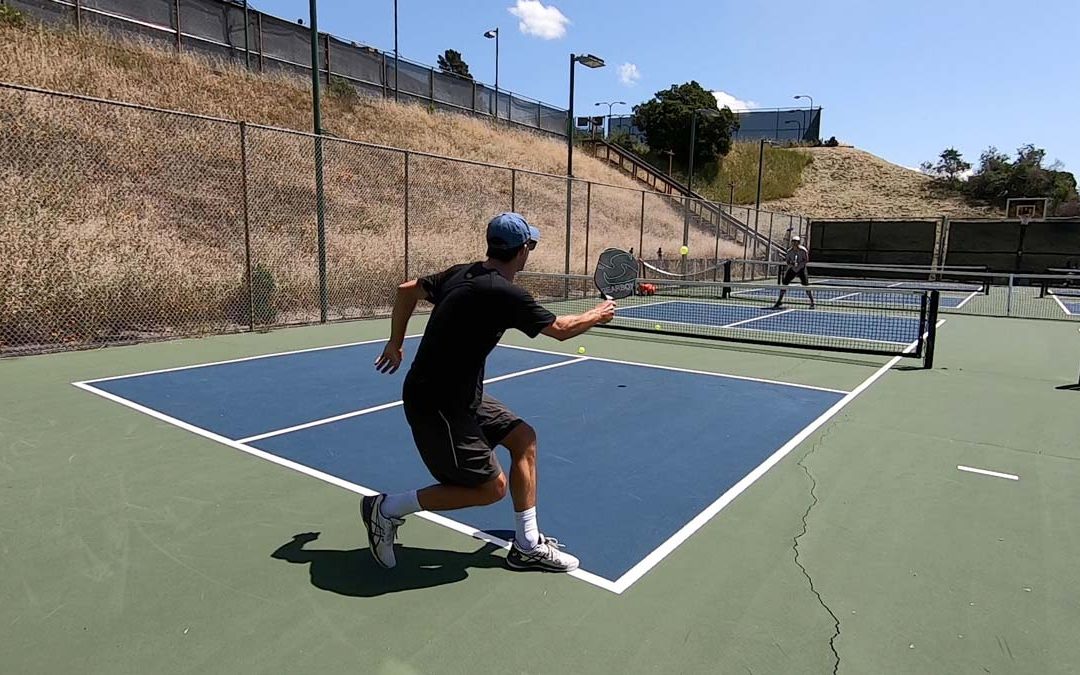Whether you’re curious about this game you’ve heard of called pickleball and are interested in jumping in on the fun or you want a resource to help someone you know get started, you’re in the right place.
This is the definitive “How To Play Pickleball Guide”.
We’ll cover all the basics you need to know about this fun game that’s sweeping the nation.
Equipment
One of the great benefits of pickleball is that the equipment needed is rather minimal.
It comes down to a paddle, a ball, and court shoes.
And then ultimately you need a court to play on as well.
As the sport grows there are more and more of those popping up all the time so finding one should be relatively easy and it’s getting easier all the time.
There are a wide variety of paddles that can work for you.
We recommend you steer clear of wooden paddles because they’re quite heavy and you’ll outgrow them fairly quickly.
A composite paddle of some kind would be best. See image below.
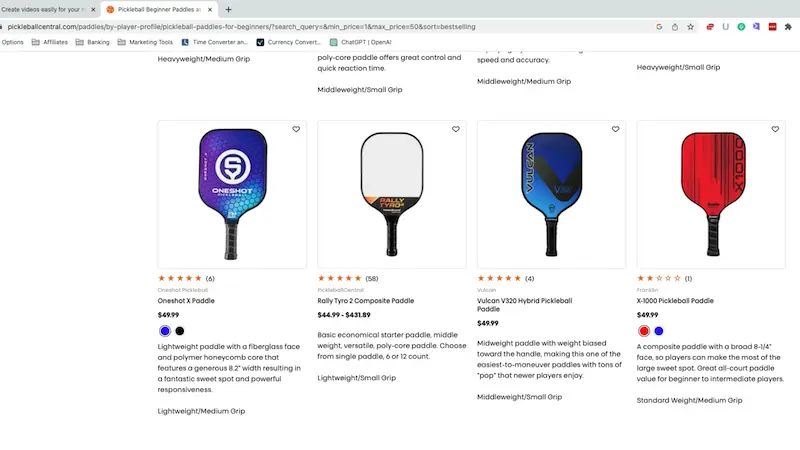
You can likely borrow one from a friend, a local pickleball enthusiast or they may have some available for checkout at your local pickleball venue.
Or, you can grab an inexpensive paddle online for about $50-$100. A paddle in that range should serve you well for some time.
I recommend using Pickleball Central. They have an incredibly wide selection and their customer support is very helpful and friendly.
They also give you 30 days to test out your paddle which is great because if you don’t like it for any reason, you can simply return it for a full refund. All you must pay is the return shipping.
This ensures you don’t get stuck with a paddle you don’t like, even if you’ve used it.
Please use this link to access their website. I’ll get a small commission at no extra cost to you.
As far as balls go, the harder ones (seen in image below) are designed for hard court play and is often referred to as an outdoor ball. Even though it’s typically the court’s surface that dictates the type of ball that you should use.
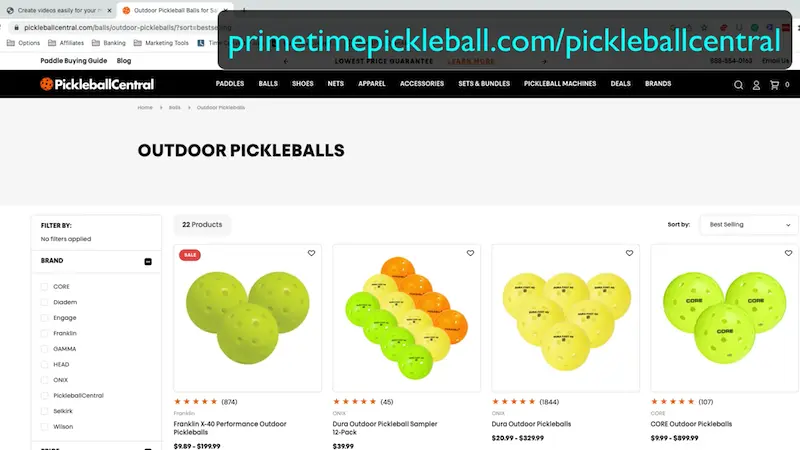
The type of ball that feels just a little bit more rubbery is designed for gym courts that have hardwood flooring and is typically referred to as an indoor ball (see image below).
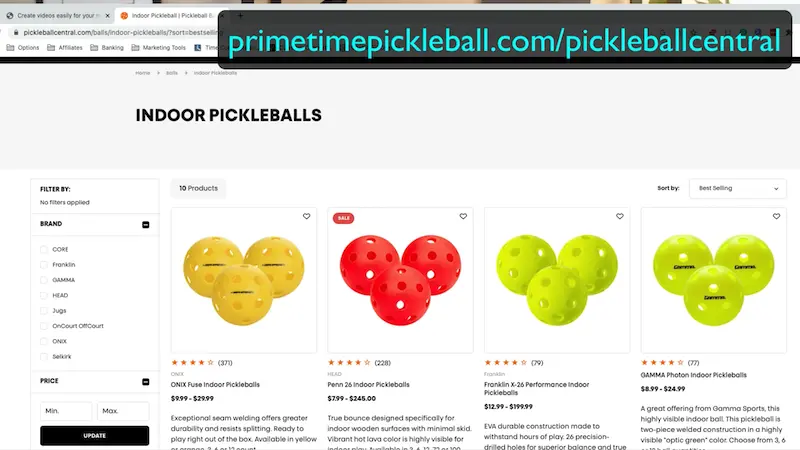
You might want to bring a few balls to the court each time you play in case one cracks while you’re playing.
As far as shoes go, tennis shoes on hard court surfaces are usually best as they are designed for movement in all directions, including lateral movement.
If you’re going to be playing on an indoor court (wooden floor), then a basketball shoe or a volleyball shoe will work well for that type of surface. Even a badminton shoes will do.
Running shoes are not advisable as they are only designed for front to back movement.
There is tons of lateral movement in pickleball which makes running shoes a bad choice and puts you at risk of ankle injuries.
Those are the equipment basics.
You’ll also want to wear comfortable athletic clothing, bring water, and possibly a hat and sunscreen for sun protection if you’re playing outdoors.
Pickleball can be played in singles format (1 vs.1) or doubles format (2 vs.2).
Most recreational play is played in the doubles format, so we’ll be focusing on that.
Pickleball Court & Key Rules
Let’s dive into the rules and key components of how the game of pickleball is played, the pickleball court, and key rules.
This is what a pickleball court looks like.
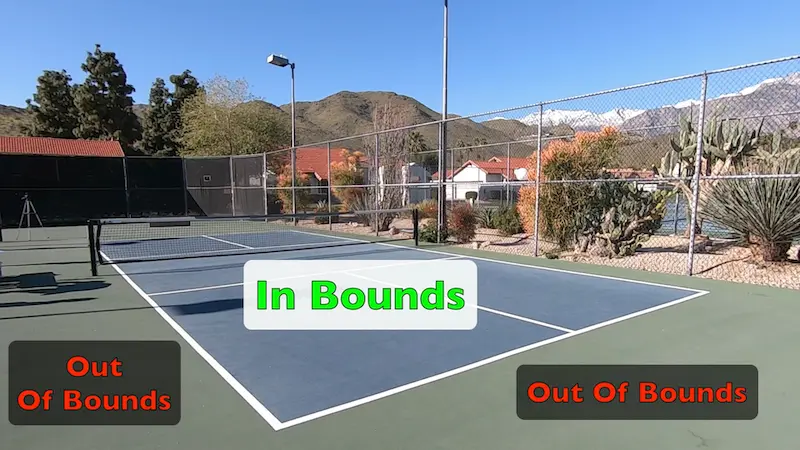
The court is divided into 2 different areas by the net and lines.
In the most general sense, there is a ball in bounds area and a ball out of bounds area.
For most of the point, except on the serve, which we will discuss in more detail shortly, the ball can land anywhere in this area (see image below) and is considered to be in play. This includes landing on any line.
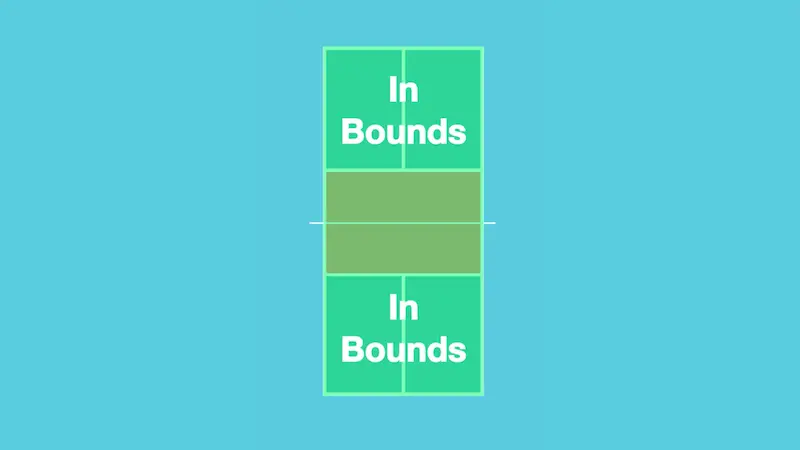
Should the ball land outside this area it is considered to be out of play which is a fault and ends the point.
The Lines
The boundaries of the inbounds area of the court are the baseline and the sidelines.
The inner lines of the court are the center lines which is the line that divides the service areas on each side of the court and the non-volley zone line which creates a non-volley zone on each half of the court.
The non-volley zone and associated line is a unique feature of pickleball, and we’ll go into more detail on that later.
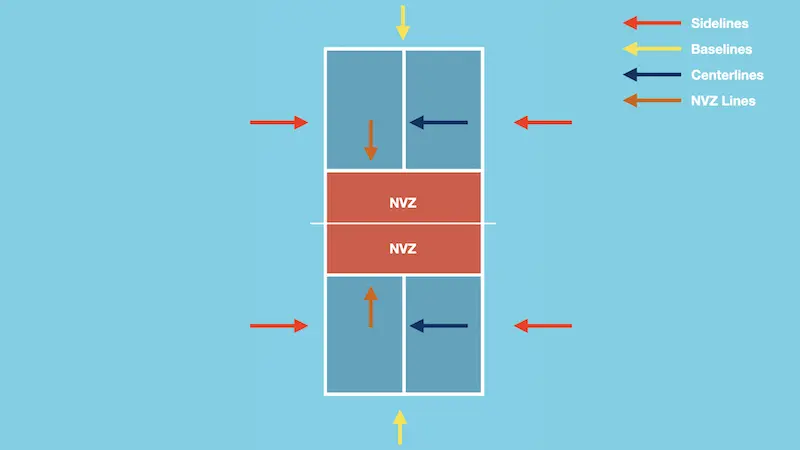
The Net
The court is divided into two playing halves by the net.
If you hit the ball in the net that is a fault and the point ends.
The general goal of each shot is to get the ball over the net and inbounds.
Service Areas
Each half of the court has two service areas. The right side service area and the left side service area.
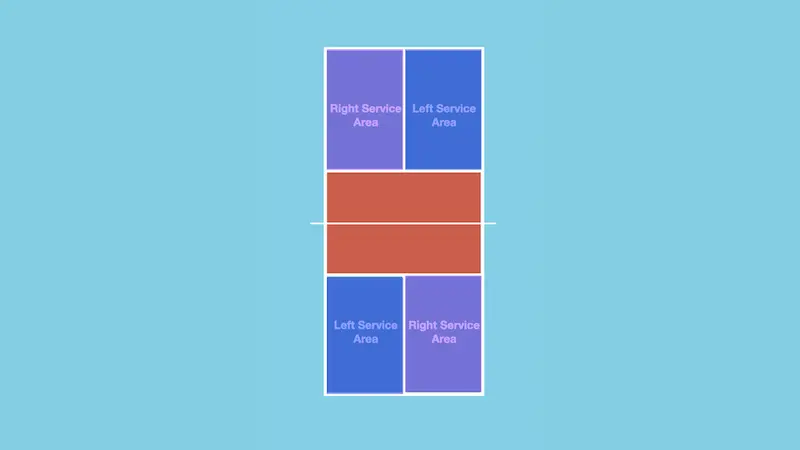
The first shot of each point is the serve.
The server will either be serving from the right or from the left to start the point.
More on when they will serve from each side later.
Regardless of what side you serve from, your serve must land in the service area on the other half of the court diagonal from you and beyond the non-volley zone line.
The non-volley zone line is considered to be part of the non-volley zone and is out of bounds for the serve.
Non-Volley Zone
The non-volley zone, which is also referred to as the kitchen, is a very important area in the game of pickleball and is a big part of what makes pickleball distinctive from other racket or paddle sports.
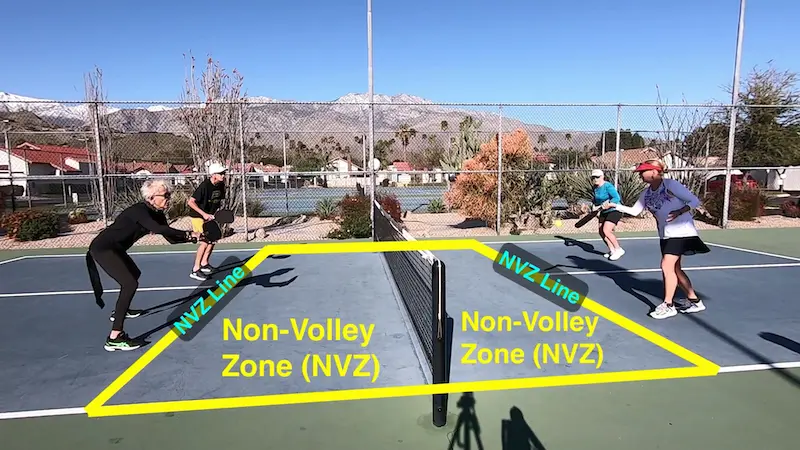
The rule of this zone is that you cannot be standing in this zone and take the ball on the fly as it comes over from the other half of the court.
Taking the ball on the fly is called a volley, hence why it’s called the non-volley zone.
If this rule were not in place, then a team could simply blanket the net and continuously hit hard and down, back to the other half, often for winners and that just wouldn’t be very much fun.
Preventing that is why the non-volley zone was established and is what leads to a game that is generally more fun thanks to its longer rallies.
One very important detail to elaborate on when it comes to this rule is that even if you make contact with the ball, with both feet behind the non-volley zone line, and you volleyed it, and your momentum from hitting that shot carries you into the non-volley zone, then that is a fault, and you lose the point.
The key word there is momentum.
If you hit the volley and establish yourself with balance outside the non-volley zone and then step into it, that is okay.
There is a common misconception about the non-volley zone that you can’t even enter it until the ball has bounced on your side. That is not true.
You can enter at any time you wish as long as you do not hit a volley.
Below we see that a player has stepped into the non-volley zone before the ball has bounced. The ball then bounces, and the player hits it over. That is perfectly acceptable since the player did not hit a volley regardless of when they stepped in to hit that shot.
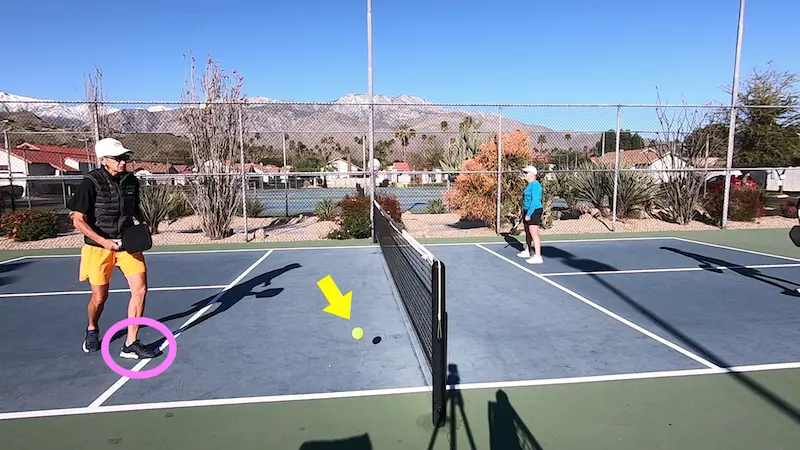
Two Bounce Rule (Double Bounce Rule)
The two bounce rule states that the ball must bounce once after the serve and once after the return.
After that you can play the ball out of the air or after one bounce for the rest of the point. Except of course, as previously mentioned, you can’t volley while stepping in the non-volley zone which includes stepping on the non-volley zone line.
Faults
Faults are events that end a point.
The team that committed the fault loses the point.
The most common faults that end a point are when a player hits a ball into the net or when a player hits a ball out of bounds or when a team has let the ball bounce twice on their half before being able to return it assuming the first bounce landed in.
These are the three most common ways to lose a point that every beginner needs to know.
Points
A game is usually scored to 11 points, and you must win by 2 points.
You will find this to be true of recreational play and most play in general anywhere you go.
Only the serving team can score a point. More on that later.
In certain situations, usually in tournament play, scoring can go to 15 or 21.
Which Team Serves First?
At most pickleball facilities that you go to, the team that serves first will often be designated by some kind of nearby landmark and that will become the custom at those courts.
Let’s consider an example facility with courts near a street. The people that play at that facility might say that the first team to serve is always the one on the half of the court closest to the street and that’s just how it will be every time you come out to play at those courts.
It’s a very casual approach but that’s just how it’s typically done.
We’ve now covered some of the most important general key rules to know.
There are a few more important rules that are better explained in the context of other key concepts coming up. So, let’s continue on.
Basic Strategy & Positioning
The general objective of a pickleball game is to get the ball back over the net and in play one more time than the other team.
Each time you do that, you win the point or the rally.
Those two terms, rally, and point are often used interchangeably. However, you don’t always score a point even if you win the point.
As mentioned previously, you can only score a point when you are the serving team.
When you are the returning team, you are attempting to win back your team’s right to serve and score points.
More on scoring and who serves when later.
Strategically the best place for you and your partner to be, with respect to your overall objective of getting one more ball back in play than your opponents, is up at the non-volley zone line.
From up there you have the most opportunities to hit forceful shots that your opponents will have a hard time returning.
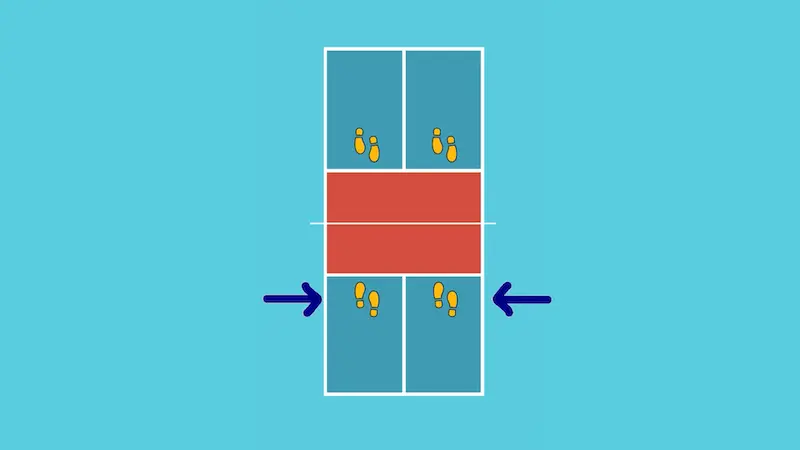
And from up there you minimize the gaps that they have available to hit to you on your half of the court.
Both you and your partner should strive to get up to the non-volley zone line as soon as possible after the serve or return.
The other team will be doing the same and two skilled teams will likely have many slow and rapid exchanges with both teams at, or approaching, the non-volley zone line.
It’s important to note, that especially as you’re learning the game, you may find that many points are over before getting up to the non-volley zone line ever happens.
This is usually because it can take several shots, hit well, to transition up there from where you started the point which was back behind the baseline.
Also, some players prefer to default to staying back near the baseline, especially if they are former tennis players, simply because they’re more comfortable playing from back there and hitting ground strokes off the bounce.
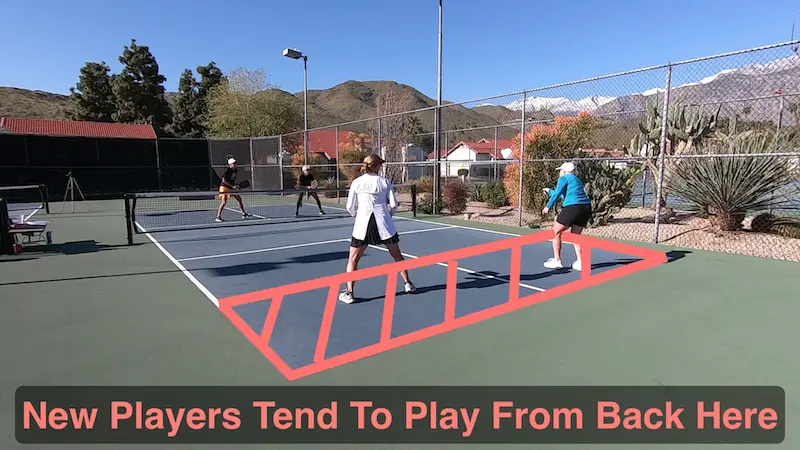
That’s okay. Players can choose to play in any style that they wish.
Simply remember that the most skilled players, and the ones that ultimately have the most success with the game, are actively striving to be up at the non-volley zone line.
It’s truly the most advantageous place to be because of the laws of physics and geometry.
Starting Positions
We’ll now go over the key concept of starting positions for all four players on the court and then tie that all together in the scoring section to follow.
Usually, throughout the course of a game, each team will have multiple opportunities to be the serving team, and the returning team, because many sideouts will occur over the course of a game.
A sideout is simply the term used to describe when the serving team becomes the returning team, and vice versa.
More on when this event occurs to come.
It could happen that the first team to serve runs away with it and wins the game 11 to 0, which means that the team that started out returning was unable to win a single point.
It does happen but it is somewhat rare for two teams to be so lopsided in skill.
Also, there is a rule that does help to mitigate this from happening which we will cover shortly. Stay tuned.
Serving Team
First, we’ll talk about the serving team.
As previously mentioned, you can only score as the serving team.
Both players on the serving team will position themselves behind the baseline to start the point because of the two bounce rule.
The server must serve starting with both feet behind the baseline as a rule.
And since the shot that comes back must bounce it makes sense for the server’s partner to also be back behind the baseline so they don’t get caught volleying the next shot that comes back which could very well happen if they start with their position more up in the court.
The first player to serve at the start of the game, and after every sideout, is the player on the right side of the court at that time.
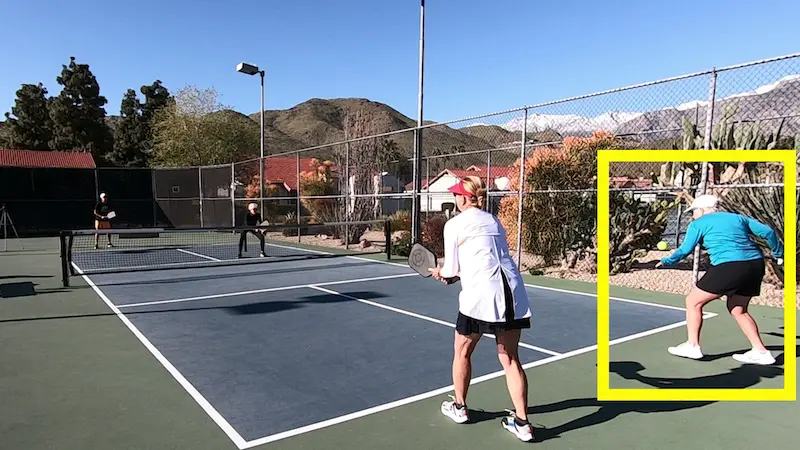
That will not necessarily be the same player on a team every time.
This will become clear as we go.
You, as a team, can decide who that player will be at the very start of the game and then the score and switching will dictate who is on the right after every sideout from then on throughout the rest of the game.
Each player on the serving team will have a chance to serve every time that team is the serving team with one exception. More on that exception later.
When the serving team scores a point the players on the serving team switch sides for the next point. The same player continues to serve until the serving team loses a point.
At that time the serving team does not switch sides. The other player on the team becomes the server and serves from the side they are on.
Again, the serving team will continue to switch sides after each point while the second server is serving as long as they continue to win points.
Once they lose a point with that second server serving, the ball then goes over to the other half of the court and the other team becomes the serving team.
As mentioned previously this switch is called a sideout.
Receiving Team
The receiving team should position themselves with the returner behind the baseline ready to receive the serve, and their partner up at the non-volley zone line.
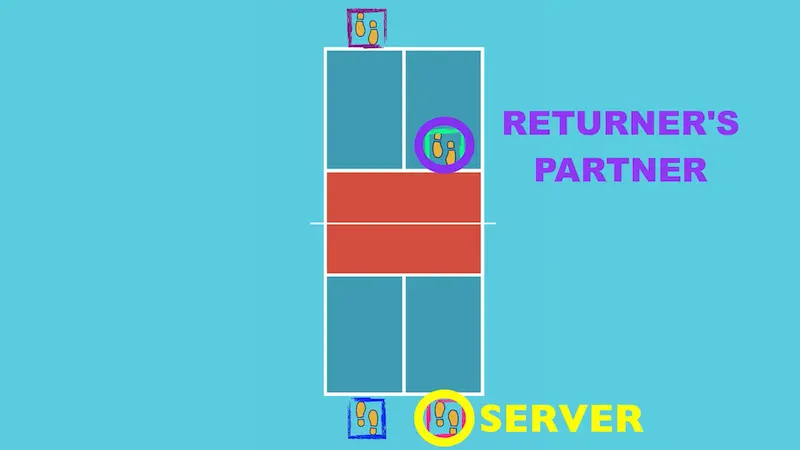
You as a team can decide who the first returner will be at the very start of the game and then the score and switching will dictate who is on the right side after every sideout from then on throughout the rest of the game.
Should the serving team win the point, the serving team will switch sides and the same server will now be serving from the left.
The returning team does not switch sides.
The other player on the returning team will now be the returner and should start the point from behind the baseline while their partner now starts the point from up at the non-volley zone line.
As we discussed earlier, the net is the most advantageous place to be in the game and since the returner’s partner is not making a play on the ball until after the two bounce rule has been completed it only makes sense that they position themselves up their right away at the start of the point because the first time they have a chance to make a play on the ball they can do so with a volley.
That is not true of any other player on the court.
As we mentioned the returning team does not switch sides regardless of if they win or lose the point.
Between points they will remain on the same side and only move up in the court and start at the non-volley zone line if they are not the returner and move back and start the point from behind the baseline if they are the returner.
First Serve Exception Rule
Remember when we talked about the first team to serve having an advantage because only the serving team can score, and they could possibly run away with the game quickly?
Well this is the rule that’s designed to prevent that.
For the team that starts the game as the serving team, only one server will have the opportunity to serve on that turn.
Once they lose a point, the ball goes to the other team to serve and from then on each player on a team will have a turn to serve after each sideout as previously described.
It’s important to understand this as we head into the key concept of scoring.
This will all come to life in the live examples we will describe coming up later.
Scoring
Before each point the server will call out the score.
They will call out three numbers.
The first number is the number of points the serving team has, the second number is the number of points the returning team has and the third number is the server number.
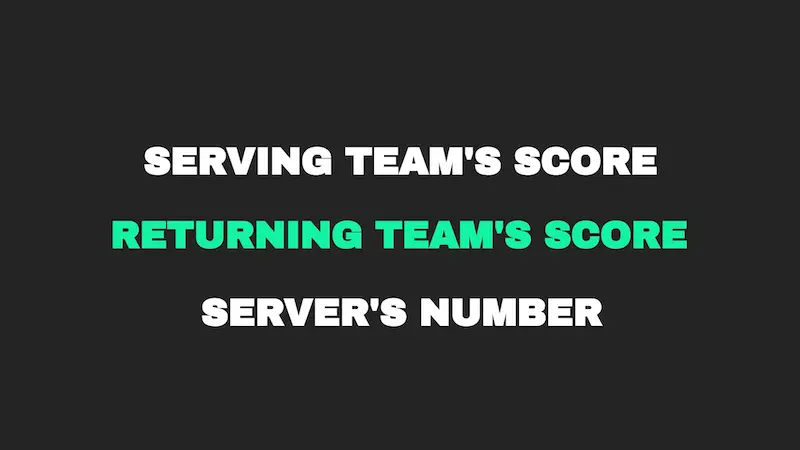
Remember we said that each player will have their turn to serve after each sideout.
So that third number will always be either a 1 or a 2.
A 1 to represent the first server on that turn and a 2 to represent the second server on that turn.
Let’s say a sideout has just occurred and my team is now the serving team, and I am the player on the right so I will be first to serve.
My team has 4 points, and the other team has 6 points.
I will call out 4-6-1 before I serve.
Let’s say we lose that point. We do not switch sides because we lost the point. The ball goes to my partner who is on the left.
She will call out 4-6-2.
We lose the point again. That triggers a sideout and the serve now goes over to the other team that now becomes the serving team.
The player on the right calls out 6-4-1 before they serve.
That’s the gist of how scoring works.
Now remember about the first server exception rule which states that only one player, the one on the right side, gets to serve on the first service turn of the game?
Well, that’s what makes the very first time the score is called out just a tad bit strange.
The score that is called out at the very start of the game is 0-0-2 because a side out will occur right away when the serving team loses a point.
Their partner will not get a chance to serve on that turn.
You can think of it as the first server getting essentially skipped on that very first turn to serve and we started with the second server hence why we always start with the score 0-0-2.
Let’s say the serving team loses the first point, the ball goes over to the other side and the player on the right is the first server on that turn.
The score they call out is 0-0-1 because from now on both players will have their turn to serve after each sideout.
Let’s describe a few examples to bring the us all to life.
Example
We’ve decided that Miriam will start as the first server. I am her partner.
Maggie is on the far side returning so she is behind the baseline.
Irene is the returner’s partner, so she is up at the non-volley zone line.
Miriam will call out a score of 0-0-2 and then serve the ball to start the point.
We, as the serving team, lost the point. Because of the first server exception rule I will not get a turn to serve this time. So, a side out occurs, and the ball goes over to the other side.
They now become the serving team.
We are the receiving team.
Since we lost the point, we do not switch sides.
Miriam is now the returner, and I am the returner’s partner.
Because Maggie was on the right side when the side out occurred, she is the first server, and she will call it a score of 0-0-1.
They lost that point.
The ball now goes to the second server who is Irene.
They will not switch sides since they lost the point and Irene will serve from the left side which is where she already was.
I move back to become the returner; Miriam moves up to start the point and she is the returner’s partner.
Irene will call out a score of 0-0-2 before serving.
They won that point.
Since they are the serving team, they score a point.
They also switch sides.
Irene now moves to the right and serves from there and Maggie is on the left.
Miriam is now the returner, and I am the returner’s partner.
Irene will now call out a score of 1-0-2 before serving.
We won that point.
Since now both Maggie and Irene have had their chance to serve a sideout occurs and we become the serving team again and they become the receiving team.
Since Miriam started the previous point on the right side, she is the right side player after this sideout and will be the first server for our team on this turn to serve.
Should we lose a point I will then get my chance to serve on this service turn for our team.
Key Serve Rules
Before we send you off to the court to play there’s just one more important thing new players need to know and that is key serve rules.
The serve is unique in the sense that it’s the shot that has by far the most rules about how it can be hit.
These rules are primarily designed to limit how powerfully you can hit the serve.
As we already touched upon, you should start your serve with both feet behind the baseline and you can’t step into the court or on the line until after you’ve contacted the ball.
The full rules regarding your feet on the serve are a bit more nuanced than that but for simplicity that’s all you really need to know.
Although you can serve with the forehand or backhand, the forehand serve is what’s used most, almost exclusively. So, we’ll cover that one.
There are two general options you can use for your serve anytime you step up to serve.
The volley serve or the drop serve.
Let’s start with the volley serve rules.
Volley Serve
When you toss the ball and hit it on the fly from out of your hand that is a volley serve.
Your serve motion for the volley serve must meet these three requirements to be considered legal.
Number one, your hitting arm must be moving in an upward arc at the time you strike the ball with your paddle.
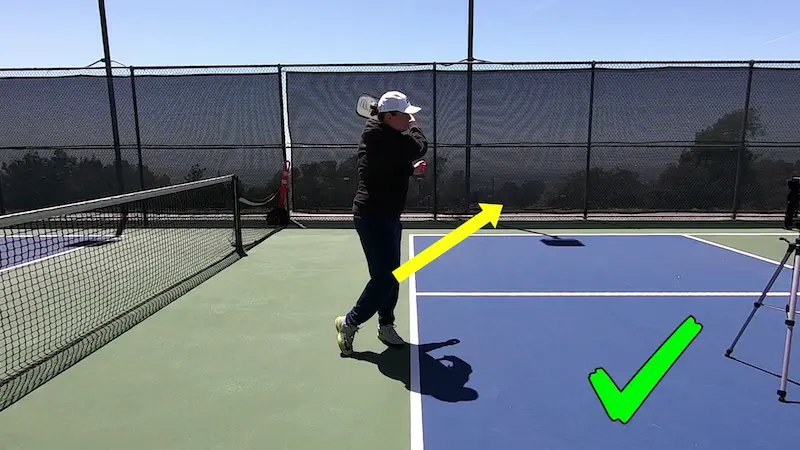
Number two, the highest point of your paddle head must not be above the highest part of your wrist when the paddle strikes the ball.
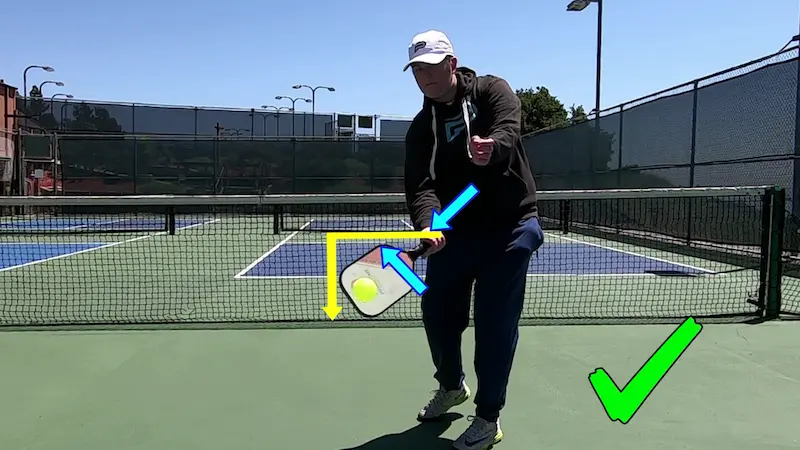
Number three, contact with the ball must not be made above the waist.
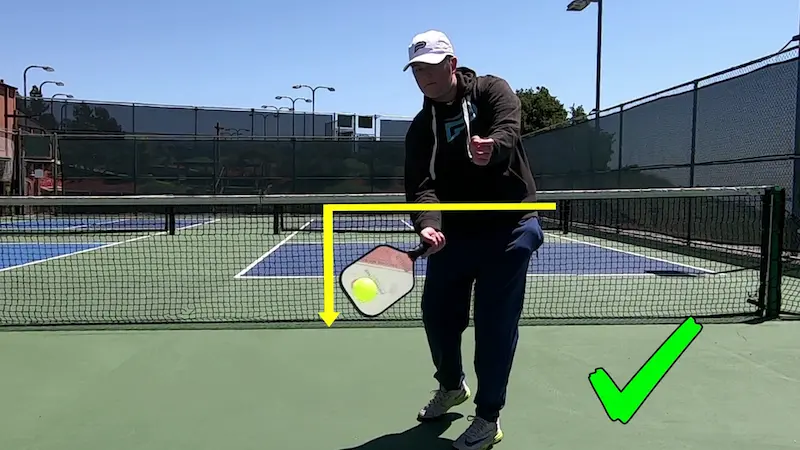
There is some confusion and discussion around this one because people tend to have different ideas about the exact location of the waist.
Although it’s not in the rules, it’s generally accepted that the navel is used as the marker since nobody disagrees about the location of the navel.
Drop Serve
The other option you can use is the drop serve.
When you release the ball and let it bounce before striking it, that is a drop serve.
The three requirements for the volley serve do not apply to the drop serve.
If you choose to use a drop serve, then these are the rules that apply.
Number one, there are no restrictions to how many times you let the ball bounce although I recommend you let it bounce only once so you can get the highest contact point possible.
Number two, the ball can bounce anywhere. Some players get the impression that the bounce must be behind the line. That is not true.
The ball can bounce behind the line, on the line, or inside the court.
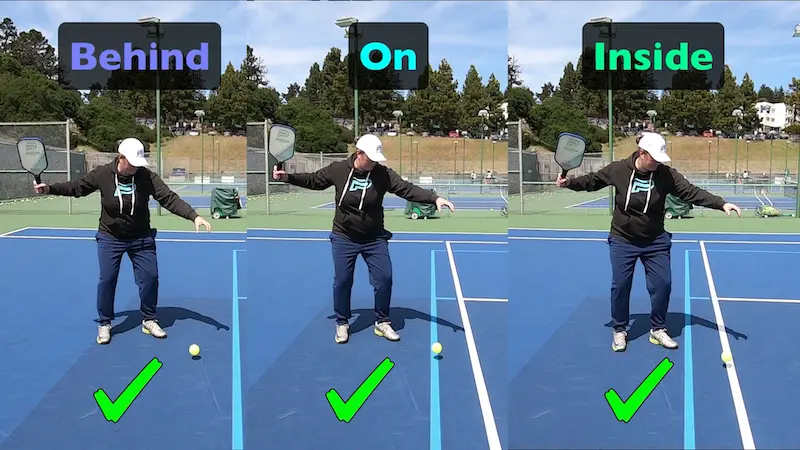
Number three, the ball cannot be propelled upward or downward on your toss.
You must only release it.
You can do so from any height you wish but it must be a simple release with no assistance from force.
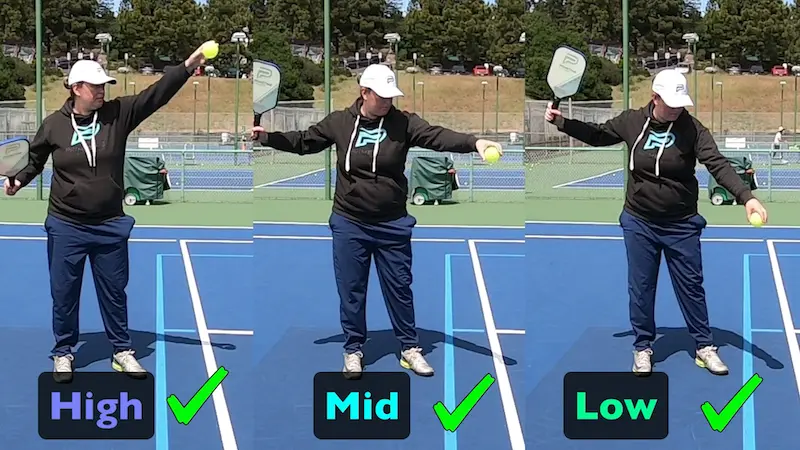
Most players choose to use the volley serve since you can typically achieve a higher contact point with the volley serve.
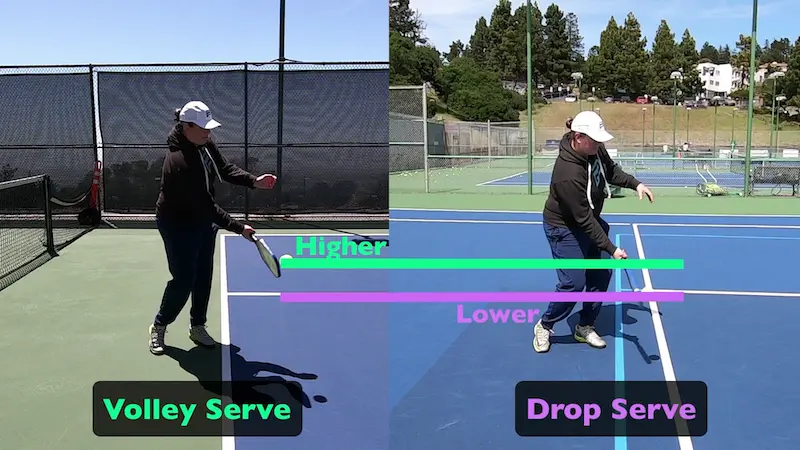
A higher contact point is always desirable in pickleball since you must hit less upward to clear the net and can therefore typically hit a more effective shot.
Yet, many new players find it easier to time a drop serve as opposed to a volley serve.
Initially, routinely getting your serve in is more important than maximizing the impact of your serve on your opponents. Try both and do what works best for you.
You can now hit the courts with confidence knowing that you have the information you need to be successful all while having a blast from the get-go.


